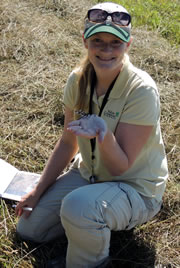Rescuing roadside reptiles
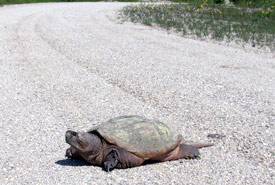
Snapping turtle crossing the road, ON (Photo by NCC)
It was a warm, late-June evening, while driving on a backroad near my home in Guelph, Ontario, when I saw a familiar sight up ahead: a car pulled off to the side of the road, at least one human standing on the road, looking concerned, and the dome of a turtle's shell frozen in the middle of the road. Before I had even pulled my car over, I knew it was going to be a snapping turtle.
Snapping turtles are unable to pull their heads into their shells. They rely on a defense mechanism of "snapping" their head, neck and jaw in one fluid, freaky movement directed at anything or anyone that gets a little too close for comfort. So while Ontarians are amazingly good at helping a friendly neighbourhood painted turtle or Blanding's turtle cross the road, especially since these turtles tuck handily back into their shell for easy transport, snapping turtles are a different ball game.
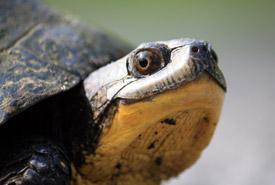
Blanding's turtle (Photo by Gabrielle Fortin)
Education about turtle conservation and news stories about turtles have been on the rise in recent years, inspiring more Ontarians (and Canadians) to get engaged in the plight of these incredible species. Unfortunately, this summer, a state of emergency has been declared on the status of Ontario's turtles. The main driver behind this is unknown, though it’s suspected that the rainy summer is playing a role, encouraging more movement of these vulnerable animals across Ontario's busy roads.
Highway shoulders with soft gravel are a perfect nesting ground for many of our turtle species. If you do happen to see a turtle trying to cross a road, don't turn it around. Help it get to the side of the road where it was heading to avoid it trying to re-cross that road. This is a great tip to keep in mind for those adrenaline-filled moments when you encounter a turtle.
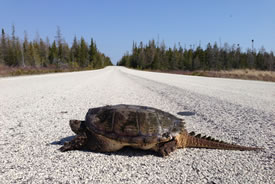
Snapping turtle on road (Photo by Tricia Stinnissen)
One way the Nature Conservancy of Canada (NCC) helps turtles, snakes and frogs, is by installing warning signs for motorists in areas where they tend to cross the road. This spring, NCC, along with the Northern Bruce Municipality, helped install “break for snakes” signage at key locations on the Saugeen Bruce Peninsula.
But back to that warm, late-June evening:
Pulling my car over to the side of the road, and feeling like a bit of a turtle superhero as I screeched to a halt, I leapt out of the car. The concerned gentleman said, "He’s not letting me help him."
Remembering the time I embarrassed two guys in their early 20s by easily moving a 1.5-foot-long snapping turtle while wearing high heels, I once again stepped in to save the day. This snapper, like many others, didn’t want to be helped, but it was employing a tactic I had never seen before. It was leaping into the air like a jackrabbit as I tried to grab the "handles" found on the very back part of its shell, on either side of its tail.
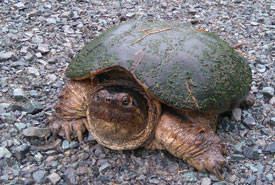
Snapping turtle (Photo by NCC)
When handling snapping turtles, the goal is to angle the turtle forward, forcing it to walk on its front feet like a "wheelbarrow" across the road. I had to try at least three times before I could get a grip on my hopping turtle. As he snapped at me angrily, I felt more and more terrible about how much I was upsetting him. Finally, he gave up and let me guide him safely onto the shoulder across the road, and shot me a dirty look when we were finished. I was left with moss, dirt and cuts on my hands, feeling that I as the turtle superhero had done the right thing, but just in a really unglamorous and ungainly fashion.
One thing that comforts me, even after performing less-than-glamorous turtle assists, is knowing that there are places like the Ontario Turtle Conservation Centre, which performs much-needed surgeries and recovery for turtles that have been struck by vehicles. I'm also thrilled about turtle road crossing infrastructure being installed in "hot spots" across Ontario. I've seen an example of one of these ecopassages in the Pottageville area, created by the Lake Simcoe and Region Conservation Authority. It’s an absolutely brilliant way of getting turtles to go under the road instead of over top of it.
Combined with the heroics of Ontario's citizens, we're all doing our best to reverse turtle population declines. So the next time you see a turtle trying to cross the road, I encourage you all to put on your superhero capes, and (safely) save a turtle's day.
When helping turtles across the road, always be mindful of traffic. Pull your car over to a safe location and only get out of your car if it is safe to do so. Children helping turtles around roadways should always be accompanied by an adult. Please ensure the safety of yourself and others first! See our video below:

